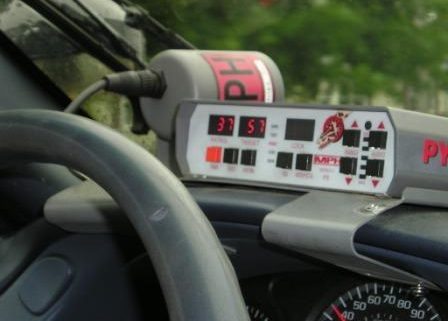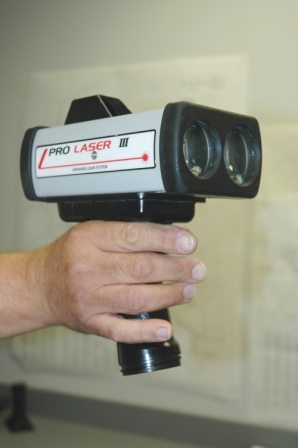Radar: How It Works
Radar is an acronym for Radio Detection and Ranging. Doppler radar units, like the one pictured above, emit a continuous frequency that bounces off a moving object, such as a car or truck. The radar unit receives the reflected signal and instantly calculates the target vehicle’s speed. Doppler radar units are capable of determining a violator’s speed while the patrol car is motion (moving radar) and, while it’s stationary (stationary radar).
In the moving radar mode, the radar unit has to determine the police car’s speed before it can calculate the speed of a target car. It does this by sending a signal to the surface of the pavement and to the surrounding landscape. The unit picks up the reflected signals and converts them to miles per hour, the police car’s speed. The patrol car’s speed is displayed as patrol speed on the face of the radar unit (far left number in the above photo). During this exchange and calculation of information the unit is also sending a signal to the target vehicle. This reflected signal is also transposed into miles per hour, the target vehicle’s speed. The target vehicle’s speed is displayed as target speed on the face of the unit (the number 57 in the above photo).
In the stationary mode, the radar unit simply subtracts the difference between the frequency it sent and the one it received. The difference is calculated and shown as miles per hour on the target screen. No patrol speed is shown when the unit is in stationary mode because the police car is not in motion.
Radar facts:
1) Police officers are not required to show the radar unit to a speeder.
2) To be certain the radar unit is operating properly, police officers must calibrate the machine before and after each shift. They do this by striking and holding a tuning fork in front of the radar unit’s antenna. Each tuning fork is designed to simulate a pre-determined speed in miles per hour. Two tuning forks are used when calibrating a radar unit – one fork is pre-set to 65 mph and the other simulates 35 mph.
The radar unit picks up the forks vibrations as speed and displays its calculation in the target speed window. If the calculated speed is the same as the speed generated by the tuning fork, the unit is operating properly.
3) Patrol car speedometers must be calibrated for accuracy on a regular basis.
4) Some police cars are equipped with devices that allow officers to swipe a person’s driver’s license like an ATM card. The machine automatically records the driver’s information and then prints out a traffic summons. The device is also capable of transmitting the data back to the police station and to the court.
5) Officers must attend a special class and attain certification before working radar.
6) A traffic stop for speeding is an arrest. Signing the ticket is the same as posting a bond. The driver’s signature on the summons is his/her promise to appear in court. A refusal to sign a traffic summons could send you to jail.
Officers use tuning forks to calibrate Doppler radar units. The gray and black device inside the car window is the rear antenna for the radar unit. The front antenna is pictured in the top photograph. It’s the round object to the left of the radar unit.
Note the patrol speed on the unit in the top photo matches the speed on the car’s speedometer.
Laser Radar
Laser radar sends a quick burst of infrared light to a speeding car. The light is reflected back and the unit calculates, in nanoseconds, how long it took the light to travel in each direction. Then, the unit transposes the information it received into the miles per hour of the target vehicle. Laser radar is an extremely accurate device and, it’s very easy for officers to use. All they have to do is point it at a moving vehicle and squeeze the trigger.
Officers simply point and pull the trigger.
The target vehicle’s speed is displayed in miles per hour.
Doppler radar units sound off (emit a tone) when a vehicle is approaching. The tone increases in pitch and volume as that car draws nearer. And it’s a sound you’ll never forget. It’ll also wake you if you happen to doze off at 4am (not that I ever did…).
Play the video to hear the Doppler tone.
*Thanks to the Hamilton and South Charleston, Ohio police departments for allowing me to ride shotgun while working radar.







I always wonder how those doohickeys work, especially when I go around a bend in the highway and find a cruiser with one pointed right at me! Thank you!
This info is so cool! Short story idea just popped into my head.
Not sure I’m liking what this can do to my hero. I hope you guys are joking.
I know what you mean, Dave. I also remember resting the handheld radar units in my lap. Haven’t been a proud Papa since.
I used to run an MR-7 moving radar. It had a large cone which you directed forward and could be placed inside or outside the car’s window. The officer I shared cars with preferred to have the cone in the car directly behind the driver’s head, so that it shot it’s beam right past, and through, your head. We were assured there was no harm to the driver.
Fortunately, to date I have not had any … um … what was I saying?